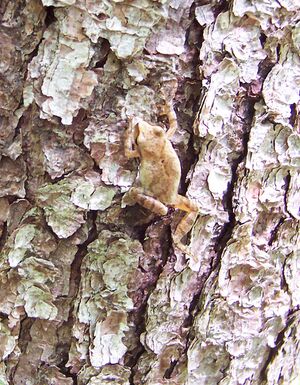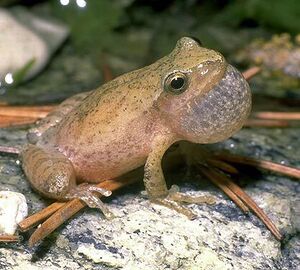Spring Peeper
The spring peeper or Pseudacris crucifer is a species of tree frog found throughout the Eastern United States and Canada.

Description
Members of the order Anura, these small frogs are only 20 to 25 mm in length, characterized by their distinctive mating calls in early spring. [1] [2] Their coloration is typically dark to light brown or drab green with a darker “X” shape across their back.[1] However, spring peepers have the ability to change shades of color depending on light and temperature [3] These changes are not drastic but allow the frog to better match the surface it is hiding on, in terms of light and shade to avoid predators. In ideal conditions these shade changes take about fifteen to twenty-five minutes, with temperature changes altering the rate at which spring peepers shift [3]

| Classification | Title |
|---|---|
| Kingdom | Animalia |
| Phylum | Chordata |
| Class | Amphibia |
| Order | Anura |
| Family | Hylidae |
| Genus | Pseudacris |
| Species | P. crucifer |
Habitat
‘’P. crucifer’’ is commonly found in and among bodies of water to breed. These water bodies can be wetlands, streams, lakes, Vernal Pools, and damp forests. [1] While being tree frogs, spring peepers tend to stay on the ground among leaf litter as adults.[1] The total range covers the Eastern United States and Canada.
Diet
Spring peepers are insectivores or organisms that eat insects, such as spiders, ants, and flies. [1] As evidenced by their calls at night peepers are nocturnal and is when they will actively hunt for their prey.

Hibernation and Calling
Spring peepers harness an extraordinary ability to hibernate during the winter. How they do this is by drastically increasing glucose concentrations in their blood through their liver by a process called glycogenolysis. [4] This hyper accumulation supplies energy to the frog letting it survive when temperatures get below freezing. When P. crucifer go to hibernate, they typically do so in layers of mud on the water’s edge or within/under fallen logs on the forest floor.[1] Upon leaving the hibernation state peepers must overcome diminished muscle performance as a side effect from freezing, as prolonged freezing results in intracellular acidosis. [4] This results in difficulties for the frog to move its muscles as it creates non-available phosphorus for the body like lactic acid build up in humans. Research indicates that the typical recovery period from this state for spring peeper’s is about eleven days.[4] After that period normal locomotion is resumed for the frogs and they have no issues jumping or swimming. Due to their low temperature tolerances spring peepers are often one of the first signs of spring. As they emerge from hibernation typically in March to breed at night. For mating males will let out a fast high-pitched ‘peep’, which is where the species gets its name from. These males will perch on a piece of vegetation overhanging the water and will call fifteen to twenty times within a minute. [2] During the height of breeding season the spring peeper’s calls can become incredibly loud and can be heard throughout the night. Mating season typically lasts from March through May and is when they call the most, fading out by summer. [2]
References
1. Gordon, Jennifer Largett; Monica Mingo; Jon Hirst; Sarah. “Pseudacris Crucifer (Spring Peeper).” Animal Diversity Web, https://animaldiversity.org/accounts/Pseudacris_crucifer/. Accessed 10 May 2022. [1]
2. Lovett, Gary M. “When Do Peepers Peep? Climate and the Date of First Calling in the Spring Peeper (Pseudacris Crucifer) in Southeastern New York State.” Northeastern Naturalist, vol. 20, no. 2, 2013, pp. 333–40. [2]
3. Kats, Lee B., and Randall G. van Dragt. “Background Color-Matching in the Spring Peeper, Hyla Crucifer.” Copeia, vol. 1986, no. 1, Feb. 1986, p. 109. https://doi.org/10.2307/1444895. [3]
4. Layne Jr., Jack R., and Matt E. Rice. “Postfreeze Locomotion Performance in Wood Frogs (Rana Sylvatica) and Spring Peepers (Pseudacris Crucifer).” Canadian Journal of Zoology, vol. 81, no. 12, Dec. 2003, pp. 2061–65. EBSCOhost, https://doi.org/10.1139/z03-202. [4]